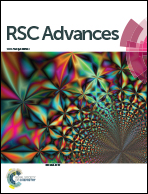Polyelectrolyte stabilized bi-metallic Au/Ag nanoclusters modified electrode for nitric oxide detection†
Abstract
In situ synthesis of bi-metallic Au/Ag nanoclusters (NCs) embedded in poly(acrylamide-co-diallyldimethylammonium chloride) (PADA) matrix and its application towards the detection of nitric oxide (NO) in nanomolar concentration range are reported. The cationic PADA matrix was used as stabilizer and support material for the preparation of bi-metallic Au/Ag NCs. The electrocatalytic oxidation and electrochemical sensing of NO were studied using the bi-metallic Au/Ag NCs modified electrodes. The modified electrode exhibited synergistic electrocatalytic activity, sensitivity and selectivity towards NO detection when compared to the mono-metallic Au and Ag nanostructures (NSs) modified electrodes. The present bi-metallic Au/Ag NCs modified electrode showed a sensitivity of 3.77 nA nM−1, a lowest experimental detection limit of 10 nM with S/N = ∼4.9, a fast response time (1 s) and a wide linear range of 10 nM to 0.9 μM towards the detection of NO. Selective sensing of NO was studied in the presence of NO3−, CO2, NH3 and other common physiological interferences.


 Please wait while we load your content...
Please wait while we load your content...